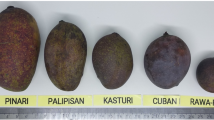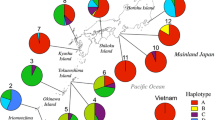Abstract
Rehmannia japonica (Thunb.) Makino ex T. Yamaz. is an endangered perennial herb species in Japan. Although earlier the Japanese considered it a variety of R. glutinosa, recent Japanese taxonomists have consistently regarded it as an independent species. According to the historical literature, Rehmannia japonica seems to have been known in China and Japan in the past. However, Chinese taxonomists do not recognize R. japonica at present. In Japan, only two populations are known, and although these populations flower every year, seed reproduction has not been observed. In this study, we aimed to reveal the phylogenetic relationships and levels of genetic diversity of R. japonica. A haplotype network based on two chloroplast DNA regions (trnL-trnF and rps16) showed that the sequences of R. japonica were distinguishable by three or four sites of indels from the most closely related species, R. chingii, consistent with the separate species status of R. japonica. An analysis of genetic diversity using twelve microsatellite loci showed that all of the ramets of R. japonica collected from two geographically isolated populations had an identical multilocus genotype, including identical heterozygous genotypes at six loci. This result indicated asexual origin of all sampled ramets. This study also suggests that the absence of sexual reproduction of R. japonica is explained by self-incompatibility combined with only a single genet remaining in the R. japonica populations.

Similar content being viewed by others
References
Albach DC, Li HQ, Zhao N, Jensen SR (2007) Molecular systematics and phytochemistry of Rehmannia (Scrophulariaceae). Biochem Syst Ecol 35:293–300
Bremer B, Bremer K, Heidari N, Erixon P, Olmstead RG, Anderberg AA, Källersjö M, Barkhordarian E (2002) Phylogenetics of asterids based on 3 coding and 3 non-coding chloroplast DNA markers and the utility of non-coding DNA at higher taxonomic levels. Mol Phylogenet Evol 24:274–301
Callaghan TV, Carlsson BÅ, Jónsdóttir IS, Svensson BM, Jonasson S (1992) Clonal plants and environmental change: introduction to the proceedings and summary. Oikos 63:341–347
Chin CL (1998) Rehmannia. In: Wu ZY, Raven PH (eds) Scrophulariaceae through Gesneriaceae, Flora of China, vol 18. Science Press, Beijing and Missouri Botanical Garden Press, St. Louis, pp 53–55
Clement M, Posada D, Crandall KA (2000) TCS: a computer program to estimate gene genealogies. Mol Ecol 9:1657–1659
Goudet J (1995) FSTAT (version 1.2): a computer program to calculate F-statistics. J Hered 86:485–486
Hara H (1949) Enumeratio Spermatophytarum Japonicarum 1. Iwanami Shoten, Tokyo
Hong DY, Yang HB, Jin CL, Holmgren NH (1998) Scrophulariaceae. In: Wu ZY, Raven PH (eds) Flora of China 18. Science Press, Beijing, pp 1–212
Isagi Y, Kaneko S (2014) Ubiquitous genotyping for conservation of endangered plant species. In: Nakano S et al (eds) Integrative observations and assessments. Springer, Tokyo, pp 311–326
Izuno A, Takamiya M, Kaneko S, Isagi Y (2011) Microsatellite loci in an endangered fern species, Athyrium viridescentipes (Woodsiaceae), and cross-species amplification. Am J Bot 98:e339–e341
Kaneko S, Kondo T, Isagi Y (2011) Development of microsatellite markers for the northern Australian endemic fan palm Livistona rigida (Arecaceae), with cross-amplification in the five related species. Conserv Genet Resour 3:697–699
Lian C, Hogetsu T (2002) Development of microsatellite markers in black locust (Robinia pseudoacasia) using a dual-suppression-PCR technique. Mol Ecol Notes 2:211–213
Lian C, Wadud MA, Geng Q, Shimatani K, Hougetsu T (2006) An improved technique for isolating codominant compound microsatellite markers. J Plant Res 119:415–417
Mabberley DJ (2008) Mabberley’s plant-book: a portable dictionary of plants, their classification and uses. Cambridge University Press, Cambridge
Makino T (1932) A contribution to the knowledge of the flora of Nippon. J Jpn Bot 8:24
Matsuda S (1918) Dziwau-zoku-oyobi-hanadziau-ni-tsuite (On Rehmannia and R. glutinosa Libosch. var. makinoi Matsuda, var. nov.). Bot Mag Tokyo 32:140–142 (in Japanese)
Milligan B (1992) Plant DNA isolation. In: Hoelzel AR (ed) Molecular genetic analysis of populations: a practical approach. IRL Press, Oxford, pp 59–88
Ministry of Environment of Japan (2015) Red Data Book 2014-Threatened Wildlife of Japan-Vol. 8, Vascular Plants. GYOSEI, Tokyo (in Japanese)
Mori K, Kaneko S, Isagi Y, Murakami N, Kato H (2008) Isolation and characterization of 10 microsatellite loci in Callicarpa subpubescens (Verbenaceae), an endemic species of the Bonin Islands. Mol Ecol Resour 8:1423–1425
Olmstead RG, Wolfe AD, Young ND, Elisons W, Reeves PA (2001) Disintegration of the Scrophulariaceae. Am J Bot 88:348–361
Oxelman B, Kornhall P, Olmstead RG, Bremer B (2005) Further disintegration of Scrophulariaceae. Taxon 54:411–425
Rozen S, Skaletsky H (2000) Primer3 on the WWW for general users and for biologist programmers. In: Krawetz S, Misener S (eds) Bioinformatics Methods and Protocols: Methods in Molecular Biology. Humana Press, Totowa, pp 365–386
Taberlet P, Gielly L, Pautou G, Bouvet J (1991) Universal primers for amplification of three non-coding regions of chloroplast DNA. Plant Mol Biol 17:1105–1109
Thompson JD, Gibson TJ, Plewniak F, Jeanmougin F, Higgins DG (1997) The CLUSTAL_X windows interface: flexible strategies for multiple sequence alignment aided by quality analysis tools. Nucleic Acids Res 25:4876–4882
Xia Z, Wang YZ, Smith JF (2009) Familial placement and relations of Rehmannia and Triaenophora (Scrophulariaceae sl) inferred from five gene regions. Am J Bot 96:519–530
Yamazaki T (1961) Meeting with Rehmannia japonica Makino. J Jpn Bot 36:351–352 (in Japanese)
Yamazaki T (1993) Scrophulariaceae 17. Rehmannia. In: Iwatsuki K, Yamazaki T, Goufford DE, Ohba H (eds) Flora of Japan IIIa. Kodansha, Tokyo, pp 343–344
Yonekura K (2012) An enumeration of the vascular plants of Japan. Hokuryukan, Tokyo
Zhou Y, Gu F, Zhou C, Chu S (2010) Genetic diversity of Rehmannia glutinosa cultivars based on sequence-related amplified polymorphism markers. Sci Hortic 125:789–794
Acknowledgements
The authors wish to acknowledge T. Kurosawa for manuscript preparation. We also thank S. Ohba, J. Fukui, and S. Sakaguchi for sampling. This work was supported by the Global Environment Research Fund (D-0903) of the Ministry of the Environment, Japan.
Author information
Authors and Affiliations
Corresponding author
Rights and permissions
About this article
Cite this article
Kaneko, S., Matsuki, Y., Qiu, YX. et al. Chloroplast DNA sequencing and detailed microsatellite genotyping of all remnant populations suggests that only a single genet survives of the critically endangered plant Rehmannia japonica . J Plant Res 130, 117–124 (2017). https://doi.org/10.1007/s10265-016-0873-5
Received:
Accepted:
Published:
Issue Date:
DOI: https://doi.org/10.1007/s10265-016-0873-5




